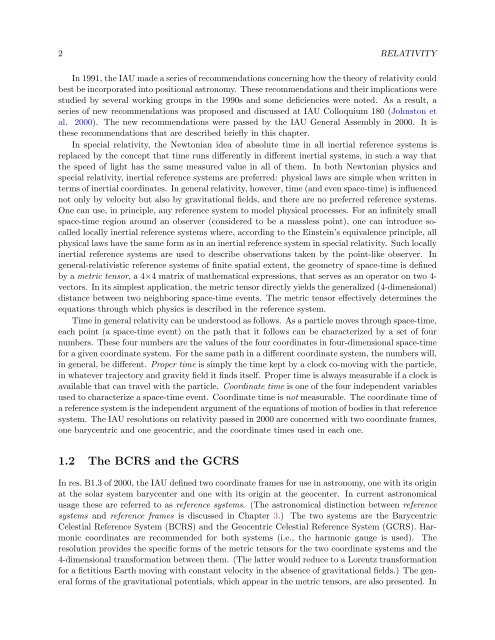USNO Circular 179 - U.S. Naval Observatory
USNO Circular 179 - U.S. Naval Observatory
USNO Circular 179 - U.S. Naval Observatory
You also want an ePaper? Increase the reach of your titles
YUMPU automatically turns print PDFs into web optimized ePapers that Google loves.
2 RELATIVITY<br />
In 1991, the IAU made a series of recommendations concerning how the theory of relativity could<br />
best be incorporated into positional astronomy. These recommendations and their implications were<br />
studied by several working groups in the 1990s and some deficiencies were noted. As a result, a<br />
series of new recommendations was proposed and discussed at IAU Colloquium 180 (Johnston et<br />
al. 2000). The new recommendations were passed by the IAU General Assembly in 2000. It is<br />
these recommendations that are described briefly in this chapter.<br />
In special relativity, the Newtonian idea of absolute time in all inertial reference systems is<br />
replaced by the concept that time runs differently in different inertial systems, in such a way that<br />
the speed of light has the same measured value in all of them. In both Newtonian physics and<br />
special relativity, inertial reference systems are preferred: physical laws are simple when written in<br />
terms of inertial coordinates. In general relativity, however, time (and even space-time) is influenced<br />
not only by velocity but also by gravitational fields, and there are no preferred reference systems.<br />
One can use, in principle, any reference system to model physical processes. For an infinitely small<br />
space-time region around an observer (considered to be a massless point), one can introduce socalled<br />
locally inertial reference systems where, according to the Einstein’s equivalence principle, all<br />
physical laws have the same form as in an inertial reference system in special relativity. Such locally<br />
inertial reference systems are used to describe observations taken by the point-like observer. In<br />
general-relativistic reference systems of finite spatial extent, the geometry of space-time is defined<br />
by a metric tensor, a 4×4 matrix of mathematical expressions, that serves as an operator on two 4vectors.<br />
In its simplest application, the metric tensor directly yields the generalized (4-dimensional)<br />
distance between two neighboring space-time events. The metric tensor effectively determines the<br />
equations through which physics is described in the reference system.<br />
Time in general relativity can be understood as follows. As a particle moves through space-time,<br />
each point (a space-time event) on the path that it follows can be characterized by a set of four<br />
numbers. These four numbers are the values of the four coordinates in four-dimensional space-time<br />
for a given coordinate system. For the same path in a different coordinate system, the numbers will,<br />
in general, be different. Proper time is simply the time kept by a clock co-moving with the particle,<br />
in whatever trajectory and gravity field it finds itself. Proper time is always measurable if a clock is<br />
available that can travel with the particle. Coordinate time is one of the four independent variables<br />
used to characterize a space-time event. Coordinate time is not measurable. The coordinate time of<br />
a reference system is the independent argument of the equations of motion of bodies in that reference<br />
system. The IAU resolutions on relativity passed in 2000 are concerned with two coordinate frames,<br />
one barycentric and one geocentric, and the coordinate times used in each one.<br />
1.2 The BCRS and the GCRS<br />
In res. B1.3 of 2000, the IAU defined two coordinate frames for use in astronomy, one with its origin<br />
at the solar system barycenter and one with its origin at the geocenter. In current astronomical<br />
usage these are referred to as reference systems. (The astronomical distinction between reference<br />
systems and reference frames is discussed in Chapter 3.) The two systems are the Barycentric<br />
Celestial Reference System (BCRS) and the Geocentric Celestial Reference System (GCRS). Harmonic<br />
coordinates are recommended for both systems (i.e., the harmonic gauge is used). The<br />
resolution provides the specific forms of the metric tensors for the two coordinate systems and the<br />
4-dimensional transformation between them. (The latter would reduce to a Lorentz transformation<br />
for a fictitious Earth moving with constant velocity in the absence of gravitational fields.) The general<br />
forms of the gravitational potentials, which appear in the metric tensors, are also presented. In


